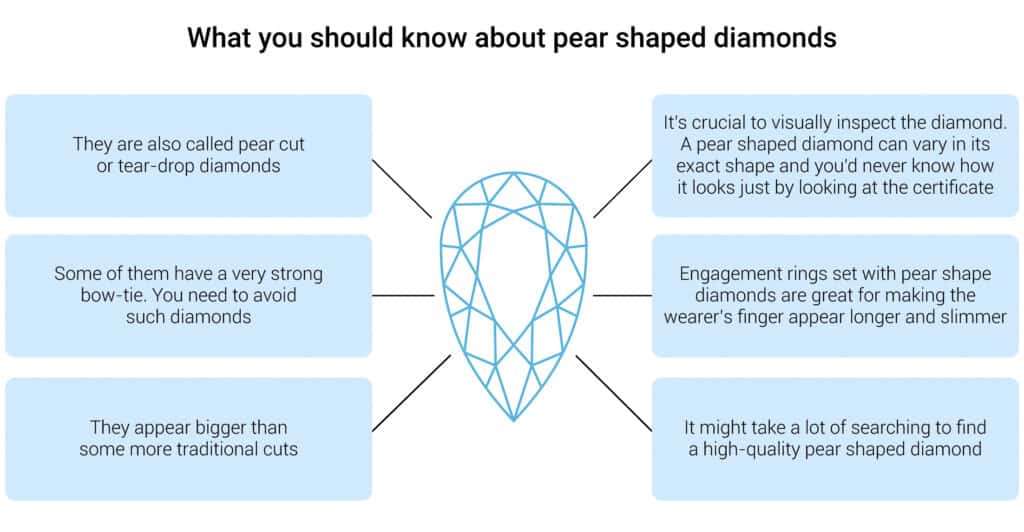Many of the emails we receive from our readers are about fancy shape diamonds, such as the princess, emerald and radiant cuts. This is no surprise, as buying a fancy shape diamond often requires paying more attention to cut parameters than a round brilliant cut diamond.
Recently, a reader contacted us asking for help selecting a pear shaped diamond for a platinum or white gold pavé setting. They were interested in diamonds in the 2.5 carat range and wanted to see what was available for $10,000, $15,000 and $20,000.
Here’s an abridged version of the reader’s first few emails:
“Hello,
I’m in the market for a diamond (for an engagement ring) and would love to hear more about your services.
I’ve attached a photo of my ideal ring – pave setting, platinum/white, pear shaped diamond. I’d love to stay around $10k for the budget… but do you think that’s realistic for a ring similar to the one attached?
Thank you!”
After we recommended this 1.50 carat, H color, SI1 clarity pear shaped diamond, the reader got back to us with the following email:
“This diamond is beautiful! I may need to increase my budget, as I’m hoping to get at least a 2 carat diamond. When I set the initial budget of $10k, I really had no idea what the current diamond prices were.
Would you be able to recommend diamond options for a $15k budget, as well as $20k?
Thank you!”
Of course, this is no problem. Not only does this type of email give us a great opportunity to help a reader find the right diamond — it’s also a great chance to discuss what you should look for in a pear shaped diamond in the 2+ carat range.
The pear shaped diamond, or teardrop diamond, is a gorgeous diamond cut with an elongated shape. It has high brilliance and a unique look that makes it stand out from most other diamond shapes, especially when it’s paired with the right setting.
Due to its unique shape, the pear shape is one of the few diamond cuts that makes the wearer’s finger appear longer and thinner. Because relatively little round diamond is discarded during the cutting process, the pear shape is also one of the more affordable diamond shapes.
Buying a pear shaped diamond can be a real challenge, as the majority of pear shape diamonds are, to put it mildly, poorly cut. We often see pear shaped diamonds with disproportionate length to width ratios, as well as shapes that are excessively flat, curvy or triangular.
Another common problem with pear shaped diamonds is the presence of a “bow tie” — a pattern that can develop in the stone when it’s viewed from certain angles.
Avoiding these problems with a pear shaped diamond can be difficult, which is why we suggest contacting us for help if you’re considering this diamond shape.
You can also use our more detailed advice below to select a pear shaped diamond with the right cut quality, clarity and color grade for optimal aesthetics and value for money.

What to Look For in a Pear Shaped Diamond
As we mentioned above, a pear shaped diamond can look absolutely stunning when it’s nicely cut. However, finding one can be a serious challenge due to the sheer number of pear shaped stones with poor cut parameters, particularly measurements.
When shopping for a round brilliant cut diamond, selecting a diamond with a good cut grade is simple. The GIA provides cut grades for all diamonds of this type, and almost all diamonds with a grade of Excellent (or Ideal, if the diamond is certified by the AGS) will be good choices.
As a fancy diamond shape, the pear shape doesn’t get a simple, one-size-fits-all grade from the GIA that you can use to assess its cut quality.
As such, it’s important to pay close attention to specific cut parameters to avoid choosing a pear shaped diamond that appears too elongated, too flat, or simply out of balance.

One cut parameter that’s especially important to look at is the diamond’s length to width ratio. A pear shape diamond will look most appealing when it has a length to width ratio of between 1.55 and 1.75.
This ratio creates a balanced looking diamond that’s neither too elongated nor too short. Tastes can vary, and the specific length to width ratio you prefer within the 1.55 to 1.75 range is largely a matter of preference.
However, we recommend avoiding any pear shaped diamond with a length to width ratio outside this range, as it will likely appear disproportionate.
The second essential aspect to look for is the diamond’s silhouette. A good looking pear shaped diamond should have a teardrop shape, with edges that are rounded rather than flat but not so curvy that the diamond appears overly wide.
When a pear shaped diamond has flat edges, it can take on an angular appearance similar to a triangle. An overly curvy pear shaped stone will look almost like an oval, without the clear point that defines its appearance and gives it its slimming effect on the finger.
This graphic from the GIA shows both issues well. On the left, you can see a balanced pear shaped diamond that has the classic teardrop appearance. In the middle, the high shoulders of the diamond give it an overly angular, almost triangular shape. On the right, the overly curvy diamond has an undefined point, giving it a distorted, oval-like appearance.
These uneven proportions and symmetry problems — high shoulders, flat wings, bulged wings and undefined points — are listed by the GIA as specific issues that can have a negative effect on a pear shaped diamond’s appearance.
This 2.01 carat, G color, SI1 clarity stone from James Allen is a great example of a pear shaped diamond with attractive proportions and a pleasing silhouette that’s neither too angular nor too round.
Similarly, this 2.01 carat, H color, SI1 clarity pear shape diamond from Blue Nile also has an excellent shape, even though the ratio is 1.51.
The final cut-related issue to be aware of with pear-shaped diamonds is presence of a “bow tie” — a dark pattern in the diamond’s facets that runs from the top to bottom of the stone when it’s viewed at certain angles.
You can see a classic bow tie pattern in this 2.00 carat, G color, SI1 clarity diamond from James Allen, pictured below on the left. In comparison, on the right, the G color, SI1 clarity diamond we linked to above is free of any visible bow tie effect, giving it a more balanced and pleasing appearance:

Achieving this balance of length to width ratio, silhouette and lack of a bow tie can be a serious challenge, and it’s not uncommon to review 20 or more pear shaped diamonds before finding a stone that passes all of the “tests” and is worth considering.
Beyond cut, there are several other major factors to keep in mind when choosing a pear shaped diamond.
The first is clarity. As always, we recommend selecting a diamond that’s eye-clean, meaning it’s free of inclusions and blemishes that are visible to the human eye in a “real-life” setting, without magnification or the bright lighting of a lab.
Because of their facet pattern, pear shaped diamonds are usually good at hiding inclusions. As such, we suggest sticking to the SI1 clarity or SI2 clarity grades for the best value, then checking each diamond carefully for inclusions using the high-resolution photos on James Allen or Blue Nile.
On the other hand, pear shaped diamonds are not particularly good at concealing color. This is largely a result of their soft sides and relatively large table, which makes the internal color of the diamond quite visible.
To avoid getting a diamond with a yellow tint, we recommend choosing a pear shaped diamond with a color grade of H or better. For a yellow gold or rose gold setting (which will pass some of its color to the diamond), it’s okay to choose a color grade of J.
Our Recommendation
A pear shaped diamond can look absolutely stunning, especially when it’s well proportioned and paired with the right setting. Because pear shaped diamonds are fairly affordable per carat, you can find excellent options in the $10,000 to $20,000 price ranges.
For example, this 1.50 carat, H color, SI1 clarity diamond available from James Allen is priced at $9,780, as well as this 1.70 carat, H color, SI1 clarity diamond from Blue Nile for $13,365.
Like with other fancy shape diamonds, it’s critical to carefully check pear shape diamonds using the photos available from James Allen or Blue Nile. Look carefully for visible inclusions, as well as the bow tie effect that can develop near the rounded end of the diamond.
If you need help reviewing pear shaped diamonds, or have any questions about the process of finding and purchasing a diamond, don’t hesitate to contact us. Our team of experts are happy to help you compare your options and find the right diamond for your tastes and budget.

- No questions asked returns within 30 days of shipment. James Allen will send you a paid shipping label to return the ring.
- Lifetime Warranty
- Free International Shipping
- Free prong tightening, repolishing, rhodium plating and cleaning every 6 months
- Provide insurance appraisals
- One free resizing within 60 days of purchase
- Free ring inscriptions
- Best-in-class high quality imagery of all diamonds in stock
- 24/7 Customer Service
- Best-in-class packaging


- No questions asked returns within 30 days of shipment. Blue Nile will send you a paid shipping label to return the ring.
- Lifetime Warranty
- Free Shipping
- Free prong tightening, repolishing, rhodium plating and cleaning every 6 months
- Provide insurance appraisal
- One free resizing within the first year of purchase
- High quality images of about half of their diamonds
- 24/7 Customer Service
- 100% credit towards future upgrades (must be at least double in value)
- Best in class fulfillment


